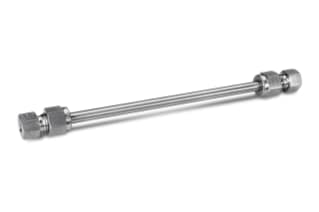
|
Chemistry |
Phenyl |
|
Separation Mode |
Reversed Phase |
|
Particle Substrate |
Silica |
|
pH Range Min |
2 pH |
|
pH Range Max |
8 pH |
|
Maximum Pressure |
6000 psi (415 Bar) |
|
Endcapped |
No |
|
Silanol Activity |
High |
|
Particle Shape |
Spherical |
|
Particle Size |
5 µm |
|
Endfitting Type |
Parker-style |
|
Pore Size |
80 Å |
|
Format |
Column |
|
Surface Area |
220 |
|
System |
HPLC |
|
USP Classification |
L11 |
|
Inner Diameter |
4.6 mm |
|
Length |
150 mm |
|
Carbon Load |
3 % |
|
UNSPSC |
41115709 |
|
Brand |
Spherisorb |
|
Product Type |
Columns |
|
Units per Package |
1 pk |

Spherisorb Phenyl Column, 80Å, 5 µm, 4.6 mm X 150 mm, 1/pk
Spherisorb Phenyl columns comprise a non-end-capped silica-based Phenyl phase that offers exceptional chemical selectivity in reversed-phase applications. Waters Spherisorb columns are among the most commonly cited HPLC columns in scientific literature. Over 2000 analytical abstracts have been published on Waters Spherisorb® columns, providing a vast array of validated techniques and applications to help you in your method development process. Parker-style tube/column end-fittings are included with these columns (or cartridge end-fittings).
The Spherisorb Phenyl Columns are reverse-phase silica columns with a pH range of 2 to 8 and a maximum pressure of 6000 psi (or 415 Bar). The Waters Spherisorb ODS2 Columns are made in a dedicated Waters chromatography chemistry manufacturing plant under the strictest cGMP, ISO 9002 requirements. They provide the most important performance characteristics, including column efficiency, peak symmetry, column longevity, and column-to-column repeatability.
You can browse our website to identify and shop for lab equipment based on your lab needs, as well as browse the numerous Waters' goods we provide for potential future purchases. Our website has an extensive tool inventory, including a list of all Spherisorb Column variants, equivalent items, and instruments that function with it in a system.
You might be interested in AutoPurification System Standard as well. The portfolio of Quality Control Reference Materials is a one-of-a-kind collection of standards and mixtures. These tools enable the user to analyze and benchmark their chromatography equipment prior to performing essential material analysis. The portfolio's goods have all been uniquely created based on the knowledge of Waters experts. Thionin, Thioflavin, and Crystal Violet are among the three components in the AutoPurification Dye Standard. Through fraction collection, this standard mix is utilized to confirm the benchmark performance of a Preparative/Purification System. This QCRM has been specially designed to allow the user to verify proper fraction collection. This test is extremely valuable to run upon first use/installation, as well as whenever the system has not been utilized or has undergone any changes.
How Does Chromatography Sensitivity Work?
Sensitivity is defined as the signal output per unit concentration or mass of a material in the mobile phase entering the detector, such as the slope of a linear calibration curve. Sensitivity is sometimes described as the ratio of peak height to analyte concentration in the peak for concentration-sensitive detectors. It is the peak height to unit mass ratio in mass-flow sensitive detectors. Sensitivity must be exclusively dependent on the chemical measuring process and not on scale factors in order to be considered a unique performance attribute.